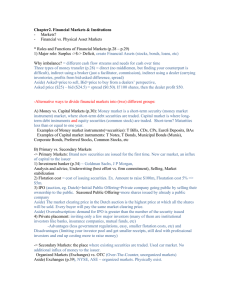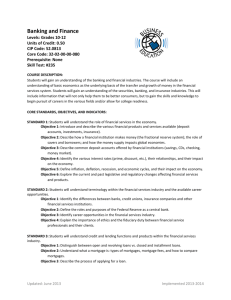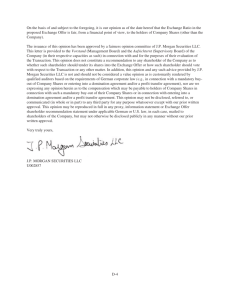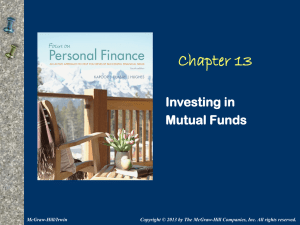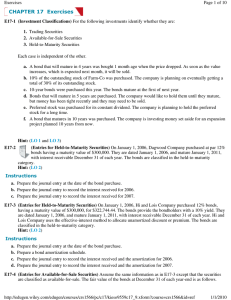Document
advertisement
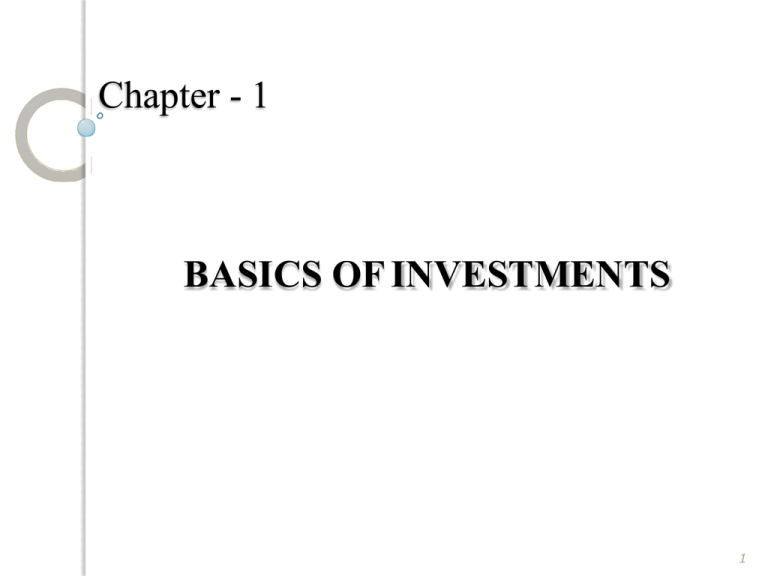
Chapter - 1 BASICS OF INVESTMENTS 1 INVESTMENT Is the current commitment of money for a period of time in order to derive future payments that will compensate the investor for a) The time the funds are committed (Pure time value of money or rate of interest) b) The expected rate of inflation, and c) The uncertainty of the future of payments (investment risk so there has to be risk premium) In short individual does trade a rupee today for some expected future stream of payments that will be greater than the current outlay. Investor invest to earn a return from savings due to their deferred consumption so they require a rate of return that compensates them. 2 What is investment? In finance, an investment is a monetary asset purchased with the idea that the asset will provide income in the future or appreciate and be sold at a higher price. Investment may be defined as………………. “a commitment of funds made in the expectation of some positive rate of return” OR it can be defined as……………….. “a sacrifice of current money or other resources for future benefits” What investment is not… Putting money into something with an expectation of gain without thorough analysis, without security of principal, and without security of return is gambling. Putting money into something with an expectation of fast gain with thorough analysis, without security of principal, and without security of return is speculation. Difference between the Investment and Speculation Investment Speculation Investment is employment of the funds It involves high risk fund It is waiting for the reward Due to risk reward is not fully considered It is used for current consumption to be used in the future. Current consumption cannot be used in future It is a long term commitment It is short term commitment Examples: Land, building, shares Examples: Lottery ticket, gambling INVESTMENT AVENUES Shares Bonds Mutual Funds Debentures PF Bank Deposits NSC Gold Silver Real Estate 7 TYPES OF INVESTMENTASSETS 1. 2. 3. 4. 5. Fixed income securities Shares Unit investment trust funds (used to be called common trust funds) Mutual funds Real estate 1. FIXED INCOME SECURITIES A group of investments that offer a fixed periodic interest returns (I.O.U.s/Promissory notes) on the principal upon maturity issued by a company or the government Types of Fixed Income Securities i. Money market instruments ii. Government bonds iii. Corporate bonds Fixed Income Securities (A)Money market instruments : short term, low default risk, lowest returns – Bank accounts, SDAs • Interest income is subject to 20% tax – Treasury bills • Bank commission fee of 1/8 of 1% (0.00125%) • Interest income is subject to 20% tax • Maturity is 1 year or less – Commercial papers • Higher yield vs. T-Bills • The company uses its reputation as collateral • Maturity is 1-30 years Fixed Income Securities (B): Government bonds : Financial instruments used by the government to borrow money from the public. ◦ Key features Safest The lowest yields among FIS of the same maturity period Fixed Income Securities (C)Corporate bonds: bonds Similar to government – Types • Debenture stocks – no asset collaterals; backed only by the creditworthiness of the issuer, not as secured as government bonds • Secured a.k.a. Loan stocks – backed by a collateral by the issuer. In case of default, investors have the right to liquidate the collateral pledged. The term and interest are fixed. • Convertible stocks – can be converted to ordinary shares of a company (e.g., part ownership of the company) 2. SHARES Shares are different from stocks, as shareholders are part owner of the company. ◦A company can be private or publicly listed. ◦Types of shares Ordinary shares – dividends are not guaranteed and the company can choose the amount wants to distribute. are guaranteed a Preferredshares: Sshareholders certain amount of dividend payment. 3. UNIT INVESTMENT TRUST FUND 4. MUTUAL FUND –Bothare open-ended investment –Both are collective investment schemes –Earns from – appreciation in the value of assets owned by the fund (bonds and/or stocks) – dividends and interest –Mutual funds are shares (NAVPS) and offered to the public by investment companies –UITFs are units of investments (NAVPU) and offered by banks –The formula to compute these prices is Net Asset Value, or the market prices of assets less liabilities, divided by total outstanding units or shares of the fund. 3. UNIT INVESTMENT TRUST FUND 4. MUTUAL FUND ◦ Types: 1.Equity or Stock Funds - shares of publicly-listed corporations. The fund objective is capital appreciation or long-term capital growth. 2.Bond Funds - fixed-income securities issued by the government or large corporations. Examples are bonds, Treasury bills, and Treasury notes. The fund objective is to provide income that is consistent with preservation of capital and liquidity. 3.Balanced Funds a mixture of equities and fixed-income securities. 4.Money Market Funds - money market funds provide the least amount of risk. Its goal is to provide current income by investing in short-term securities with portfolio duration of one year or less. These may include short-term government securities, special deposit arrangements, and time deposits, among others. 5. PROPERTIES/REAL ESTATE • ◦ ◦ ◦ • These are investments on the following: Agricultural property Domestic property Commercial/Industrial property The price of properties depends on the following: ◦ Location ◦ The quality/quantity of the crops in the land ◦ The value of the buildings in the land 6. OTHER INVESTMENTS ◦ Precious metals (gold, silver, platinum, etc.) ◦ Works of art (paintings, artifacts, jewelry, electric guitars) ◦ Rare items Things to consider in Investment 1. 2. 3. 4. 5. 6. 7. 8. Investment objectives Life cycle stages Funds availability/accessibility Level of risk tolerance Investment horizon Taxation treatment Performance of investment Diversification INVESTMENT OBJECTIVES Provide a comfortable standard of living Improve financial situation Provide income in retirement Provide funds for rearing and educating • children Provide a fund for paying necessary cost and taxes when a person dies THE LIFE STAGES Characteristics Where are you now? Pre-Family - Early 20s - Single breadwinner - Increasing income - Moderate Financial Commitment Young Family - 30's to early 40's - Married - Moderate income - High financial commitment Growing Family - 40's to early 50's - Highest financial income - Highest financial commitment Empty Nester - 50's to early 60's - Moderate income - Moderate financial commitment Retired - 60's and above - Low income - Low financial commitment THE LIFE STAGES - Considerations • Education planning for the children – High school – College • Payment for loans and mortgages – Housing – Car • Protection/income continuation – Critical illness/impaired health – Death and/or disability • Savings and retirement



